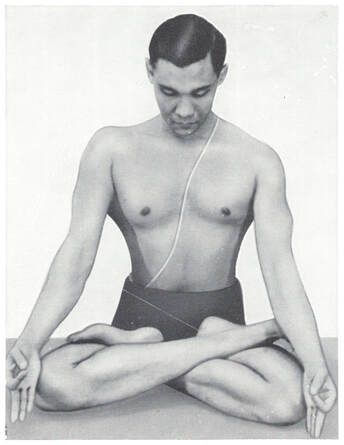|
Dr Gouri Shankar Mukerji in Padmasana This blog is in celebration of 100 years of Ghosh's College in Kolkata: 1923-2023! Spread the word: #100years #ghoshyoga There are a variety of references to 84 in texts on hathayoga. Roughly speaking, texts on hathayoga originate from between the 12th century up until the 18th century. Nowadays, "hatha" has taken on new meaning, often referring to stillness in postures, as opposed to flowing styles known as vinyasa. However, this is a newer meaning of the word. So, in this blog we are referring to the practice of hathayoga as described in the texts that comes from the period mentioned above and not the meaning it can hold today. 84 In HathaYoga Below you'll find a sample of passages that refer to the number 84: "There are as many asanas as there are species of creatures, Shiva has enumerated 84 asanas, and out of all the asanas, only two are particularly distinguished." -Goraksasatakam, 13th century “There are eighty-four asanas of various kinds which I have taught. Out of these I shall take four and describe them.” -Siva Samhita, 15th century “Eighty-four asanas were taught by Shiva. Out of those I shall now describe the four important ones.” -Hatha Yoga Pradipika, 15th century “All together there are as many asanas as there are species of living beings. Shiva has taught 8,400,000. Of these, eighty-four are preeminent, of which thirty-two are useful in the world of mortals.” -Gheranda Samhita, 17th century You will notice that 84 (or a variation of it) is always referred to, but the actual number of postures that are described in the text is far less. An Amazing Coincidence? In the first and last passage, you also see the reference to species of creatures and living beings. Miraculously, in 2011, the Census for Marine Life published a study that concluded there were 8.7 million species on Earth (+ or - 1.3 million)! The previous estimates placed the number of species between 3 million and 100 million, which was a massively large spread. Due to new analytic tools, they were able to measure more precisely and the results directly corresponded with the number of species referred to in the hathayoga texts! Conclusion Because of the idea that 84 is seen to represent something sacred or symbolic, it is referred to despite the fact that it does not correspond to the actual number of postures. Nor are the collections of postures always the same. When you come across "84 asanas" don't worry about trying to count to 84! This was never the purpose for invoking the number. Certainly don't try to figure out what is the "traditional" or "original" 84 as there never was a singular 84. Bibliography
Census for Marine Life study can be found here. Akers, B. D. trsl. (2002) The Hatha Yoga Pradipika. Woodstock: Yoga Vidya Kuvalayananda, S. and Shukla, S. A. trsl. (2006) Gorakasatakam. Kaivalyadhama: Lonavala Mallinson, J. trsl. (2004) The Gheranda Samhita. Yoga Vidya: Woodstock. Mallinson, J. trsl. (2007) The Shiva Samhita. Yoga Vidya: Woodstock.
0 Comments
Leave a Reply. |
AUTHORSScott & Ida are Yoga Acharyas (Masters of Yoga). They are scholars as well as practitioners of yogic postures, breath control and meditation. They are the head teachers of Ghosh Yoga.
POPULAR- The 113 Postures of Ghosh Yoga
- Make the Hamstrings Strong, Not Long - Understanding Chair Posture - Lock the Knee History - It Doesn't Matter If Your Head Is On Your Knee - Bow Pose (Dhanurasana) - 5 Reasons To Backbend - Origins of Standing Bow - The Traditional Yoga In Bikram's Class - What About the Women?! - Through Bishnu's Eyes - Why Teaching Is Not a Personal Practice Categories
All
Archives
May 2024
|







 RSS Feed
RSS Feed